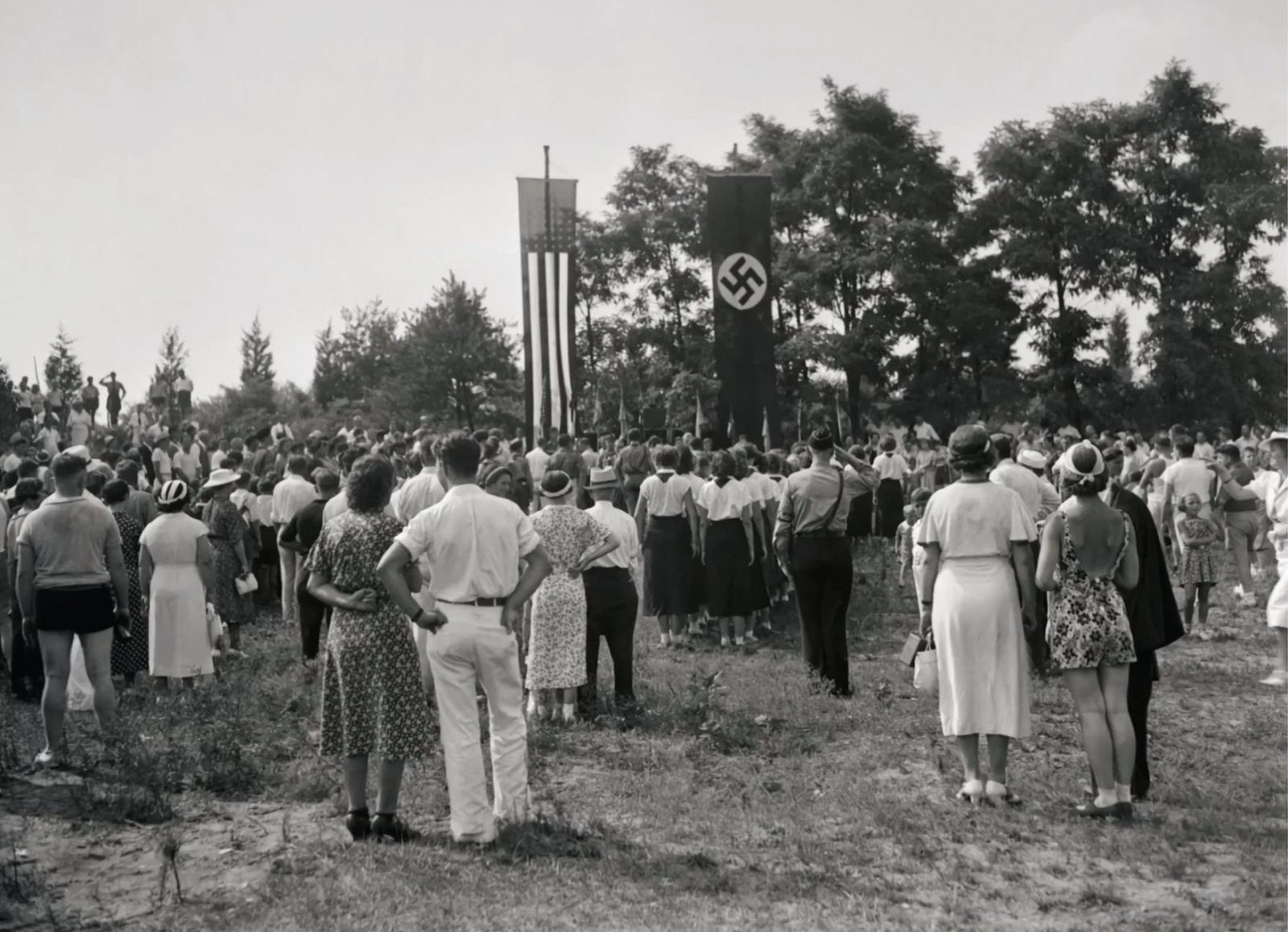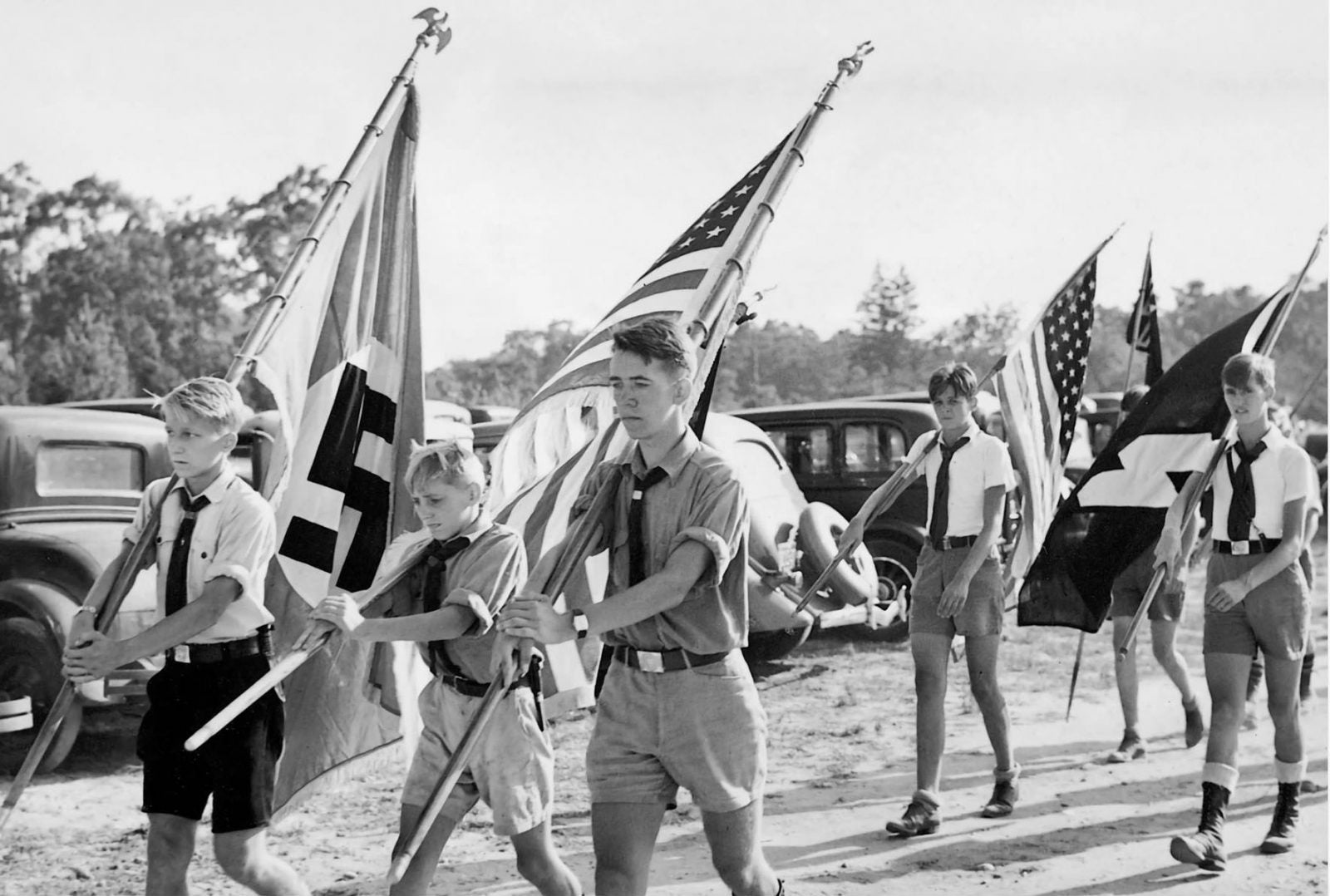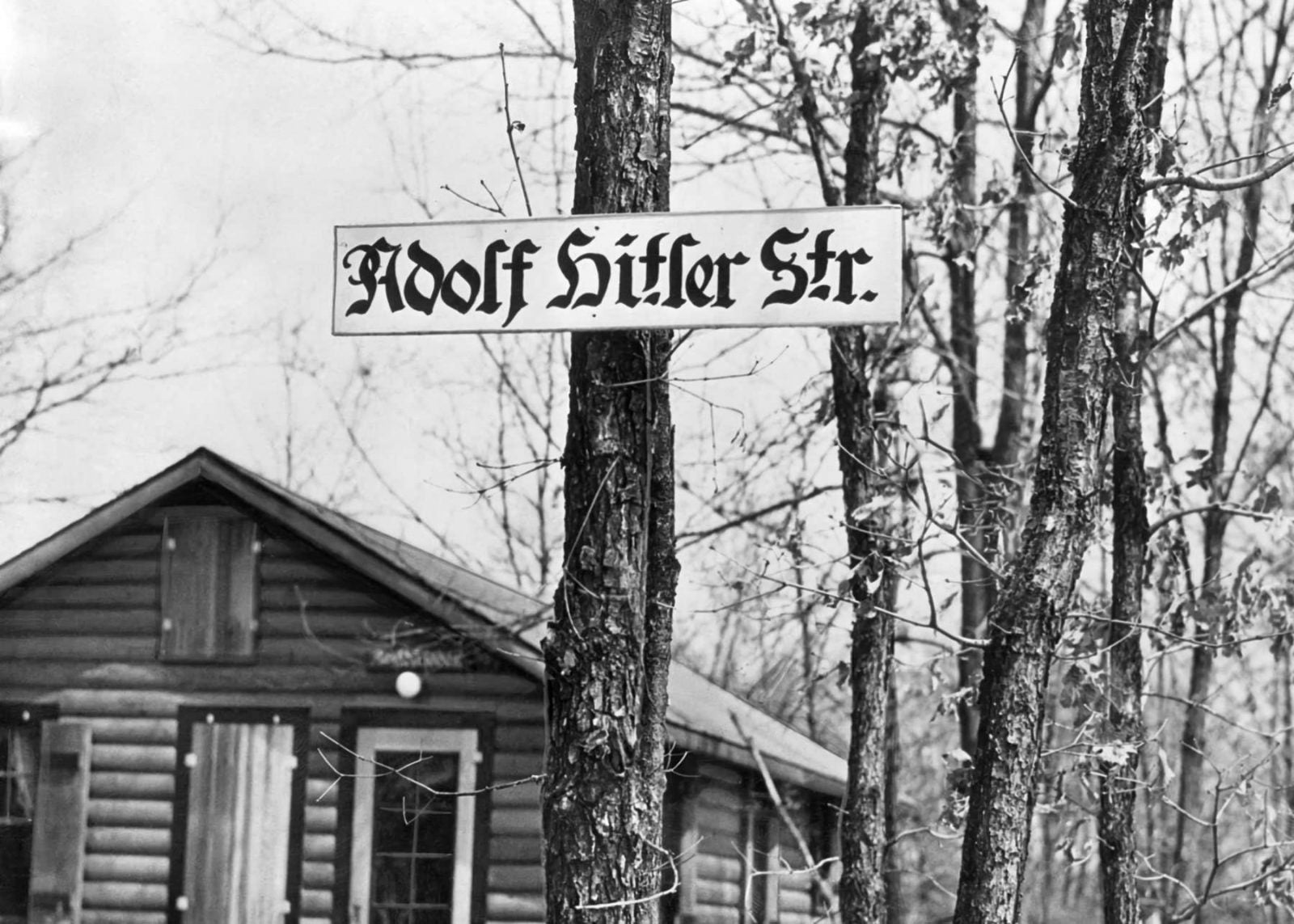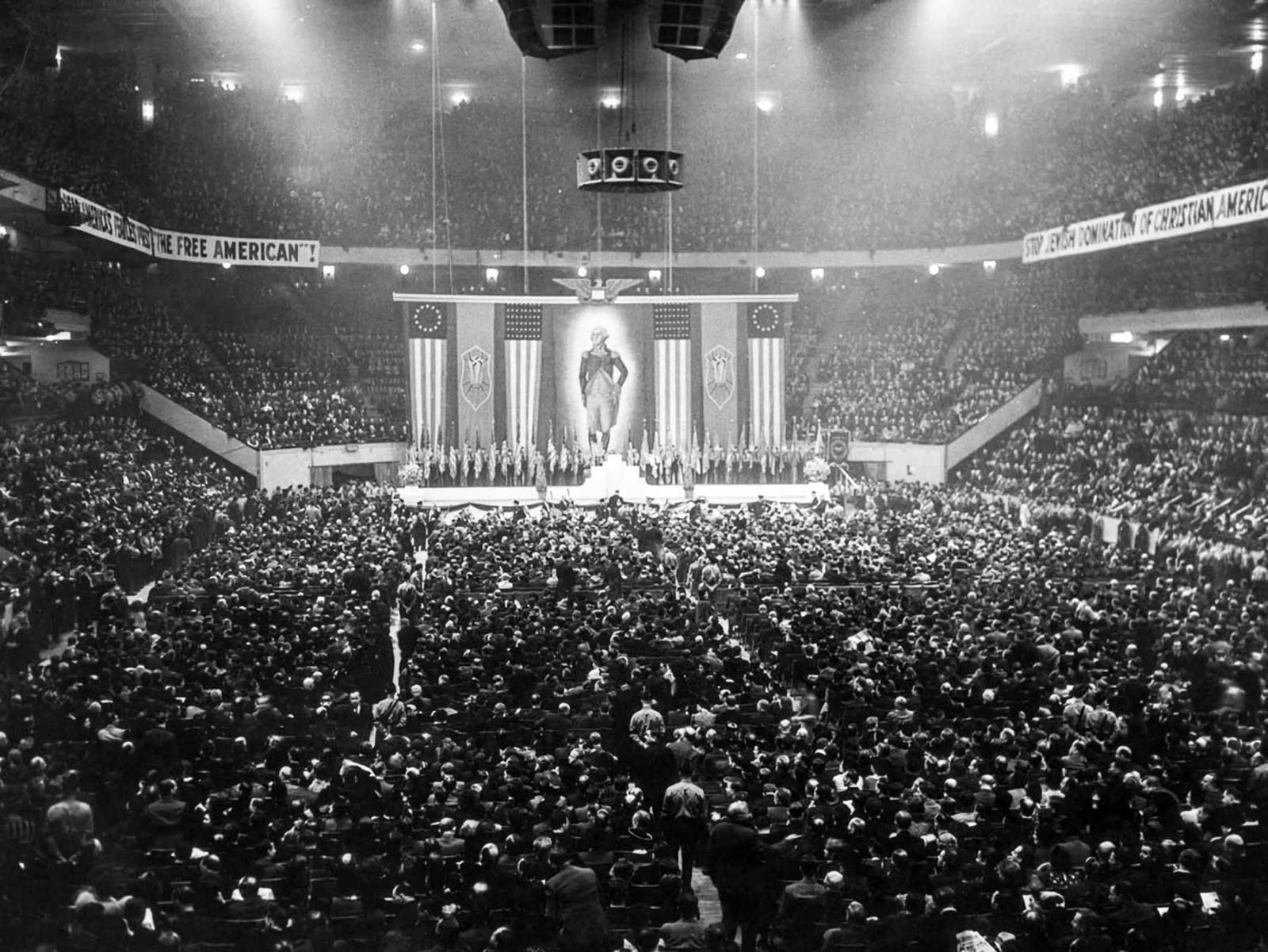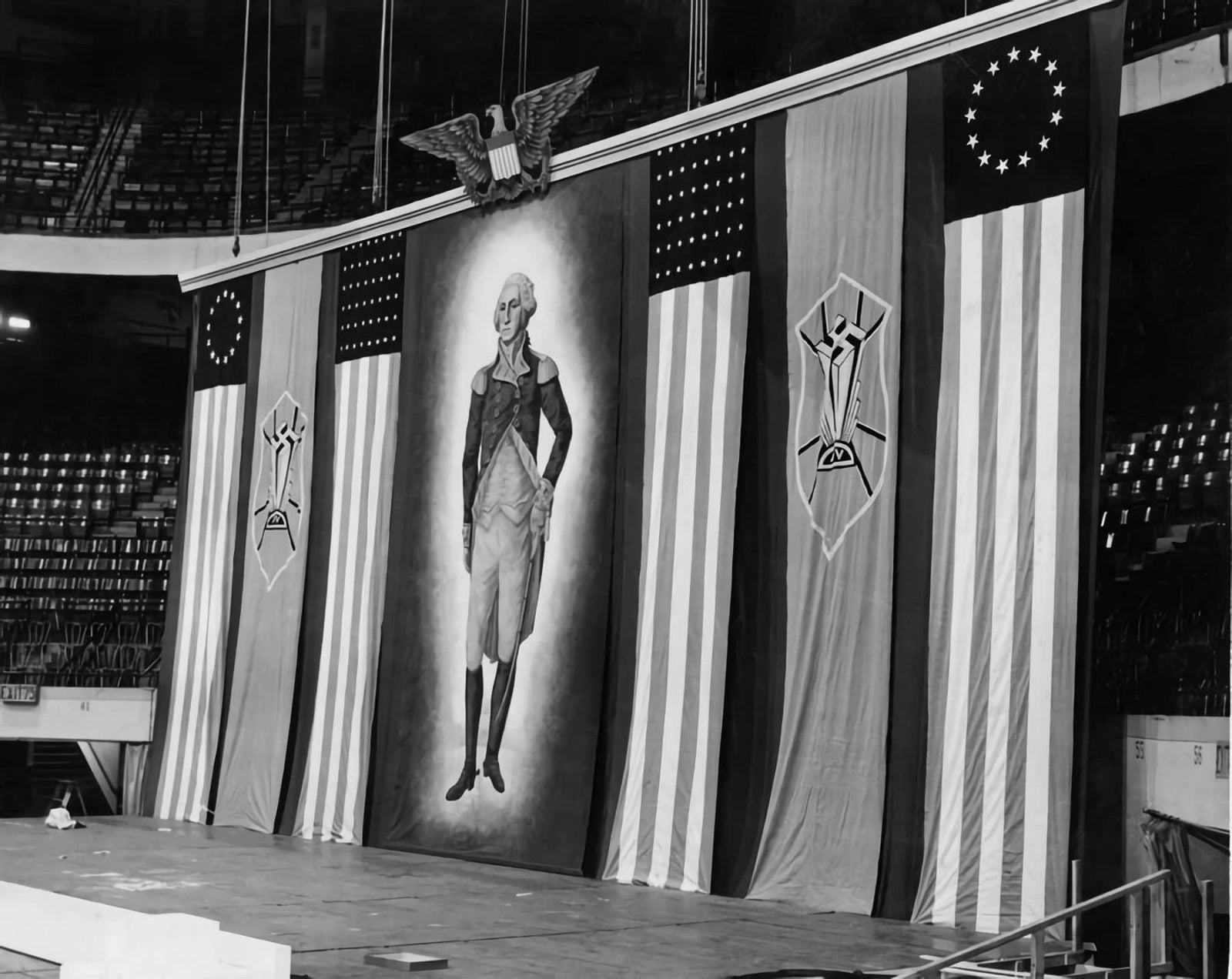History
Antisemitism in American History
From the early days of independence, America’s founders imagined the United States as a land of religious tolerance. Article IV of the United States Constitution promised that religious tests were not to be used in elections to any American office or public trust.
President Washington even expressed warm welcome to American Jews in a letter to the Hebrew Congregations of Newport, Rhode Island in 1790, promising that the United States “gives to bigotry no sanction, to persecution no assistance.”1Howard M. Sachar, A History of the Jews in America (New York: Alfred A. Knopf, 1992), 26. The U.S. Bill of Rights was approved in 1791, and its First Amendment prohibited government from impeding freedom of religion or making any law respecting the establishment of religion. Individual states, however, maintained the right to impose limitations on the rights of religious minorities, and some did so for decades against Jews, Catholics, atheists and, later, Mormons and Muslims. American antisemitism did not emerge in a vacuum, but within an imposed racial hegemony that enslaved, subjugated and discriminated against Black Americans and other minorities.2Eric L. Goldstein, The Price of Whiteness: Jews, Race, and American Identity (Princeton University Press, 2006), 1-7. The history of Jews in America is a history of the ongoing negotiation between hard-won legal freedoms and the lingering social effects of racial and religious prejudice as it persists and reignites in this country.
The first known Jews to make a permanent home in America came to the Dutch Colony of New Amsterdam (present-day New York) in 1654 — a group of 23 mostly Sephardi refugees from Recife, Brazil, which expelled its Jews that year, following Portuguese conquest.3Jonathan D. Sarna, American Judaism (Yale University Press, 2004), 1. Though the Dutch governor Peter Stuyvesant attempted to have these Jews removed, the Dutch West India Company enforced tolerance, prioritizing the perceived economic benefits of Jewish mercantile networks for the growing colony. When this first Jewish American community petitioned in 1685 for the right to worship in public, they were refused by the Common Council, which stated that this right belonged only to those who professed “faith in Christ.” But by the 18th century, synagogues were tolerated.4Jonathan D. Sarna, American Judaism (Yale University Press, 2004), 11-12. In 1740, naturalization laws included Protestant and Jewish residents, offering Jews a legal status they would not find in Europe for another 50 years. And by the time of the Revolutionary War, five small Jewish communities existed on the Atlantic seaboard.5Jon Efron, The Jews: A History (Pearson, 2009),226.
 https://en.wikipedia.org/wiki/File:Early_Jewish_Congregations_in_the_13_Colonies.jpg
https://en.wikipedia.org/wiki/File:Early_Jewish_Congregations_in_the_13_Colonies.jpg19th-Century Immigration from Europe
From 1830-1860, some 200,000 more Jewish immigrants arrived from Central Europe, motivated to find economic opportunity and leave behind those antisemitic restrictions limiting Jewish marriage, business and professional life.6Jon Efron, The Jews: A History (Pearson, 2009), 326. By and large, they found freedom and opportunity in America. However, as outsiders bearing a history of condemnation by Christianity and by emergent racial science, Jews still found themselves scapegoated in America. Because some Jews were distinguishable by surname, manners and accents, the presence of a Jewish individual within a disreputable activity, even among a majority of non-Jewish actors, lent to unjust attributions of Jewish blame, relying on age-old antisemitic stereotypes that long had flourished in Europe.
 Sarna, Jonathan, When General Grant Expelled the Jews (2012), Schocken Books https://nextbookpress.com/books/248/when-grant-expelled-the-jews/
Sarna, Jonathan, When General Grant Expelled the Jews (2012), Schocken Books https://nextbookpress.com/books/248/when-grant-expelled-the-jews/During the Civil War, for example, anti-Jewish intolerance increased dramatically on both sides, with both the Union and Confederacy making baseless accusations that Jews aided the opposing side. Newspaper cartoons depicted Jews as unpatriotic merchants who sold military supplies at artificially high prices, undermining the war effort while making a profit. General Ulysses S. Grant even issued an order to expel all Jews from the territory under his command, blaming Jews “as a class” for the smuggling and cotton speculation conducted by a diverse network of people in his region. After Jewish expulsions in northern Mississippi and Paducah, Kentucky, President Lincoln learned of Grant’s order and put a stop to it, condemning the wronging of an entire group for the behavior of only “a few sinners.”7Jonathan D. Sarna, American Judaism (Yale University Press, 2004), 120-121. Grant later apologized and spent the remainder of his life as “a friend of human rights causes generally, especially those involving Jews,” taking legal steps to protect America’s freedom of religion.8Jonathan D. Sarna, When General Grant Expelled the Jews (Knopf Doubleday, 2012), 104; 82-83.
During the Civil War, for example, anti-Jewish intolerance increased dramatically on both sides, with both the Union and Confederacy making baseless accusations that Jews aided the opposing side.
Understandably, the United States generally appealed to many Jews’ hopes for tolerance, dignity and unbiased opportunity. Thus, between 1881-1914, approximately 2,000,000 Eastern European Jews immigrated to America, escaping poverty and a violent wave of pogroms that destroyed some tens of thousands of Jewish homes and economically ruined far more families. Around 85 percent of these immigrants entered through the port of New York.9Jonathan D. Sarna, American Judaism (Yale University Press, 2004), 151-153. Lacking funds to travel further, many found skilled work in the city and made their permanent homes there.10Jon Efron, The Jews: A History (Pearson, 2009), 328. Some Americans balked at the Jewish minority and resented their presence in urban life, expressing discomfort about Jewish immigrants’ foreign mannerisms, customs and their pronounced drive to succeed in America.11Leonard Dinnerstein, Antisemitism in America (New York: Oxford University Press, 1994), 36.
Broadly speaking, however, most of these Jews acculturated into the American middle class relatively quickly and advanced professionally within the urban capitalist landscape, a fact that further fueled the resentment in some quarters. Following economic downturns in the late 19th century, for example, agrarian populists of the South and Midwest seized on conspiracy theories, claiming that urban Jews were exploiting markets and the federal government as a whole. Some such populists condemned Jews as a national threat, as an entire corrupt class of international financiers who owned the banks and ruined small family farms by promoting the gold standard.12Hasia R. Diner, The Jews of the United States, 1654 to 2000 (University of California Press, 2006), 170.
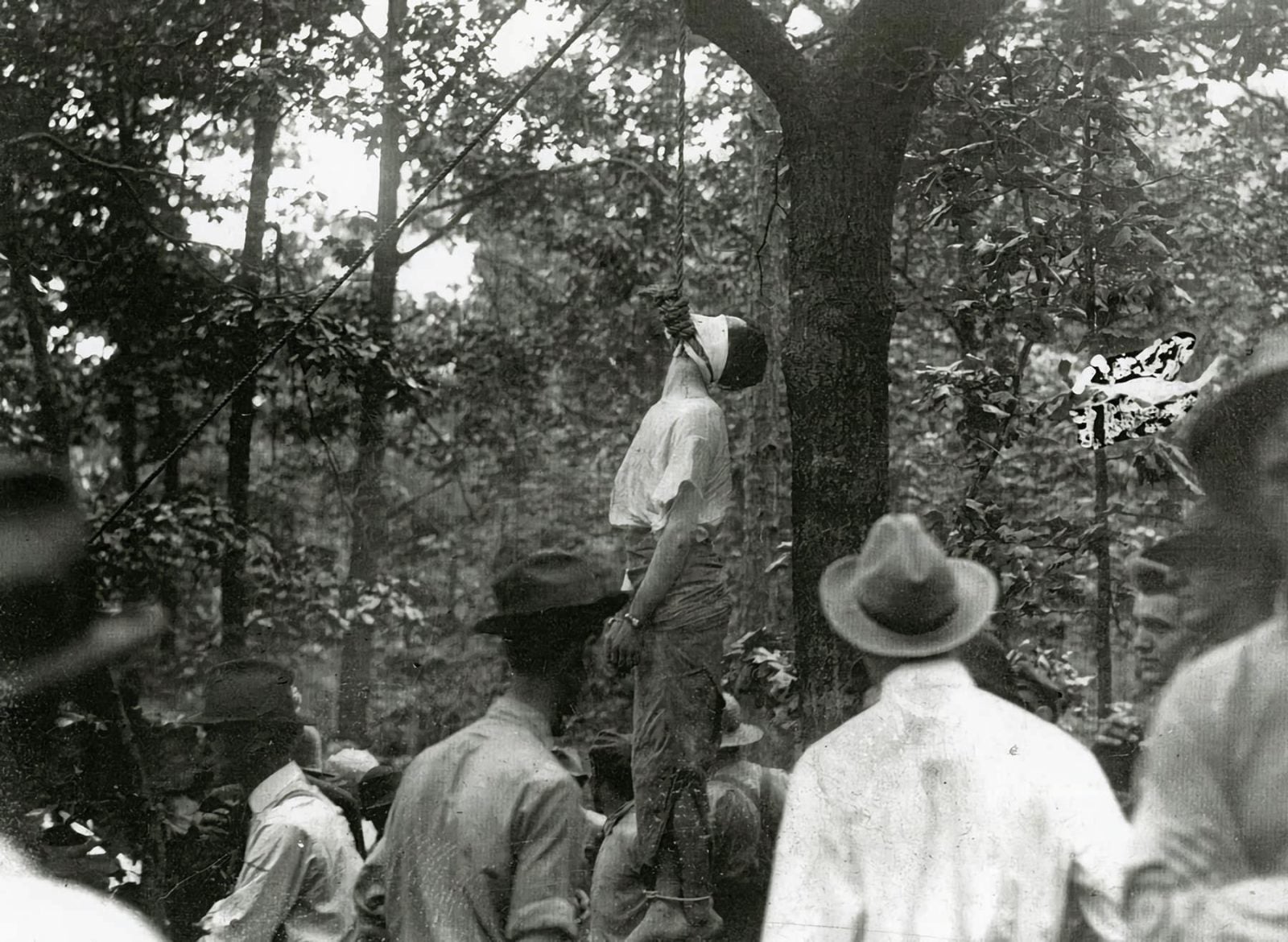
Leo Frank: Trial Tainted by Antisemitism
In rural and urban areas alike, American antisemites periodically seized on Jewishness as a means to justify blame and violence. In 1913, for example, Leo Frank, a Jewish 29-year-old factory superintendent, was convicted of murdering a young female employee in Atlanta, Georgia. Questioning the fairness of a trial tainted by overt antisemitism, in 1915 the governor of Georgia reduced Frank’s sentence from the death penalty to life imprisonment. This elicited a wave of publicity focused on Frank’s religion. An angry mob, including prominent local citizens, abducted him from prison and lynched him.13Jonathan D. Sarna, American Judaism (Yale University Press, 2004), 216. Incidents like this one raised American Jews’ anxieties about the ability or willingness of the nation’s leaders to protect Jews from popular prejudice. Mob violence against Jews and other social and religious minorities only increased during World War I, as Americans grew more embittered toward foreign nations and expressed panic about the possible spread of Bolshevism, with which they unfairly associated all Jews.14Jonathan D. Sarna, American Judaism (Yale University Press, 2004), 217. The revived Ku Klux Klan in the 1920s, which focused its violence on Black Americans and Catholics, also threatened and attacked Jews as part of a perceived threat to White America and the “Aryan race.”
Discrimination and Quotas
Civilized society also was not free of antisemitism. In the interwar years, American Jews faced educational quotas, discrimination in the professional sphere, restriction from residential and recreational communities and continued acts of outright physical violence. In relatively mainstream parts of American society, universities, clubs and other associations consistently denied membership to Jews.
In 1922, Harvard’s president proposed a 15 percent quota on the portion of Jewish students in each class, maintaining that too many Jews at the university could cause more antisemitism.15Jerome Karabel, The Chosen: The Hidden History of Admission and Exclusion at Harvard, Yale, and Princeton (Houghton Mifflin Harcourt, 2005), p 99. Yale, Princeton, Columbia and many other institutions of higher learning also limited their enrollment of Jews, as did numerous private academies and preparatory schools. Starker anti-Jewish restrictions appeared in fraternities, clubs, resorts, hotels and particular neighborhoods in which homeowners’ associations regularly restricted the sale of property to Jews.16Jewish Telegraphic Agency, Archive; “Florida Supreme Court Rule Voids Anti-jewish Restrictive Covenants,” https://www.jta.org/1959/04/22/archive/florida-supreme-court-rule-voids-anti-jewish-restrictive-covenants. Some hotels even explicitly advertised policies of “no Hebrews.”17Jonathan D. Sarna, American Judaism (Yale University Press, 2004), 219. In many ways, this systematic exclusion echoed the spirit of Jim Crow legislation that marginalized African Americans from participating fully in all aspects of society. Of course, such restrictions paled in comparison to those placed on Black Americans of the time, who endured an elaborate system of racial segregation punctuated by violence and lynching in the “Jim Crow” South, as well as harsh discrimination throughout the nation. But as with non-Jewish people of color, Jews’ encounters with America were complicated. America offered opportunity, but antisemitic accusations were prevalent where success was achieved. It offered many Jews the opportunity to assimilate into whiteness, but only sometimes, and only as part of a racist system.18Eric L. Goldstein, The Price of Whiteness: Jews, Race, and American Identity (Princeton University Press, 2006), 62-65.
Later, racist agitators actively linked anti-Jewish and anti-Black hostility and demonized both minorities in a manner that echoes contemporary models of white nationalism. Thus it was unsurprising that a large plurality of American Jews felt a marked solidarity with African Americans as mutual victims of “race hatred” and felt compelled to identify as a Jewish race deserving of racial protections, not simply religious ones. And so, as historian Eric L. Goldstein writes, “the question of whether Jews ought to fashion themselves as a race or merely a religious denomination became one of the most hotly debated issues of early-20th-century Jewish communal discourse.”19Eric L. Goldstein, The Price of Whiteness: Jews, Race, and American Identity (Princeton University Press, 2006), 84-86.

Influence of Mass Media
America’s social climate in the early 20th century was influenced by the growing popularity of mass media, including press and radio. Through these channels, some of the most influential people in the country used their national platforms to stoke hatred and fear of Jews in the interwar years. From 1920-1924, Henry Ford, one of the wealthiest and most powerful Americans, published antisemitic conspiracy theories in 91 consecutive issues of his weekly newspaper, which reached a circulation of 700,000 by 1924. Drawing from The Protocols of the Elders of Zion, he reprinted much of this content in his four-volume The International Jew, which saw hundreds of thousands of copies distributed.20Jonathan D. Sarna, American Judaism (Yale University Press, 2004), 217; Leonard Dinnerstein, Antisemitism in America (New York: Oxford University Press, 1994), 81. Hitler’s Mein Kampf would later praise Ford for these efforts.21William D. Rubinstein, “Antisemitism in the English-Speaking World,” in Albert S. Lindemann and Richard S. Levy, Antisemitism: A History (Oxford University Press, 2010), 160. Father Charles Coughlin, a Catholic figure whose weekly radio show reached 15 million listeners per week, also propagated antisemitic beliefs, justified Nazi violence against Jews overseas and provoked his American followers to paint swastikas on Jewish businesses and gang up on Jews in the streets.22Jon Efron, The Jews: A History (Pearson, 2009), 420; Albin Krebs, “Charles Coughlin, 30’s ‘Radio Priest,’” New York Times, Oct. 28, 1979. Physical attacks on Jews increased in the 1930s, especially in cities where pro-Nazi German Americans and Catholic supporters of Father Coughlin rallied in the streets.23Jonathan D. Sarna, American Judaism (Yale University Press, 2004), 220.
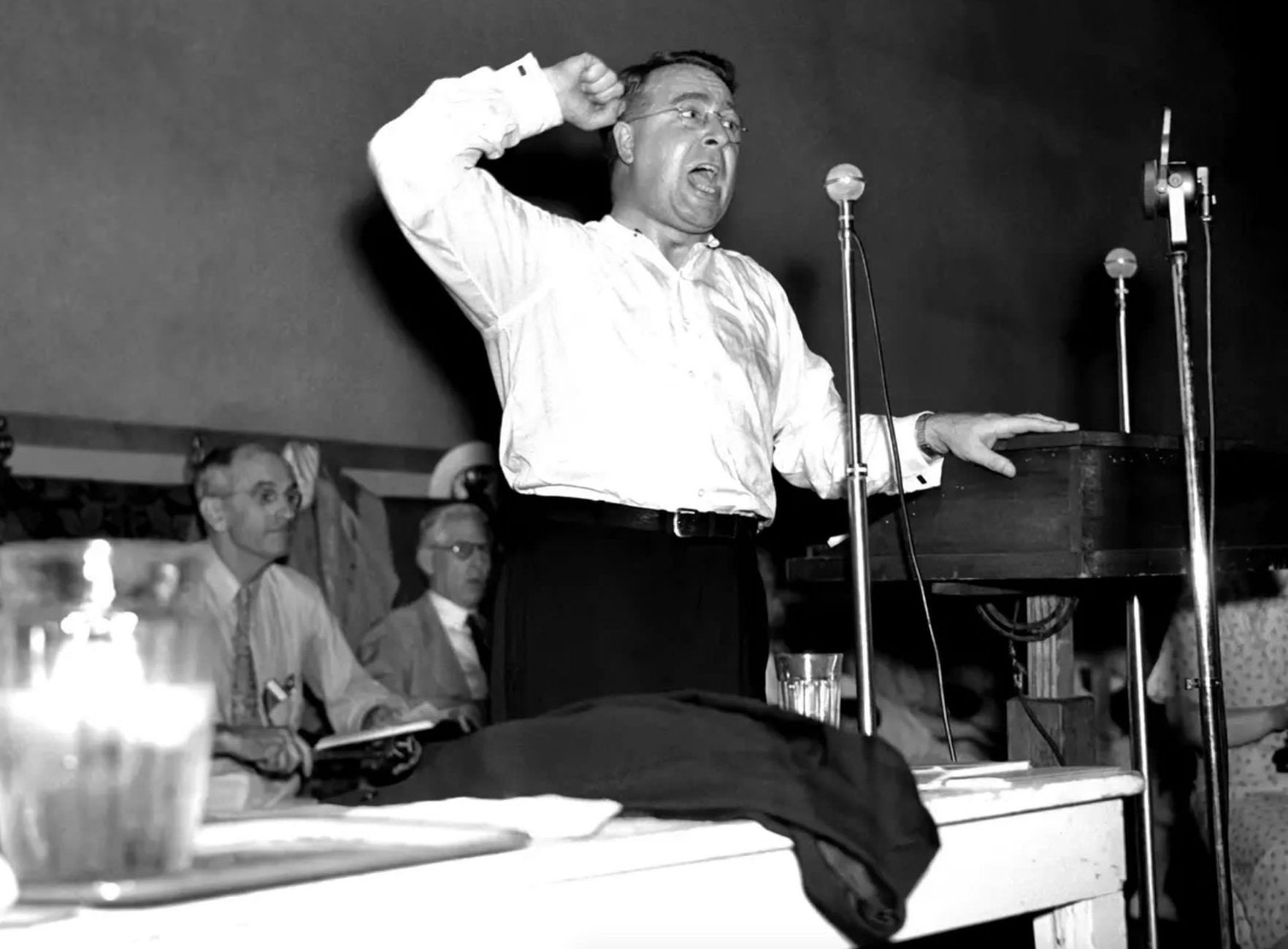 Associated Press, Rev. Charles E. Coughlin (1936), photo, AP Images http://www.apimages.com/metadata/Index/Watchf-AP-A-OH-USA-APHS121637-Rev-Charles-E-C-/1b8226ecbb824bd291ca03c3dfc47d4a/26/0 https://www.businessinsider.com/steve-bannon-father-charles-coughlin-2017-11
Associated Press, Rev. Charles E. Coughlin (1936), photo, AP Images http://www.apimages.com/metadata/Index/Watchf-AP-A-OH-USA-APHS121637-Rev-Charles-E-C-/1b8226ecbb824bd291ca03c3dfc47d4a/26/0 https://www.businessinsider.com/steve-bannon-father-charles-coughlin-2017-1120th-Century Immigration
America’s unprecedented immigration rates at the turn of the century also had led many citizens to condemn all immigrants and social non-conformists as “Bolsheviks.” In this climate, there were surges of antisemitism, along with nativism, xenophobia, racism and anti-Catholicism in the 1920s.24Jonathan D. Sarna, American Judaism (Yale University Press, 2004), 214. By 1924, Congress had imposed immigration restrictions aiming to resurrect the white Protestant character of 19th-century America. The new policies entirely prohibited Asian immigrants and severely limited entry of “undesirable” groups, which included Italians and Slavs, the latter group encompassing the Jews of Eastern and much of Central Europe. Later added to these quotas were strict administrative barriers. Thus, as Nazism rose in Europe during the 1930s, most of the Jews targeted found America’s doors closed.25Jonathan D. Sarna, American Judaism (Yale University Press, 2004), 215-216.
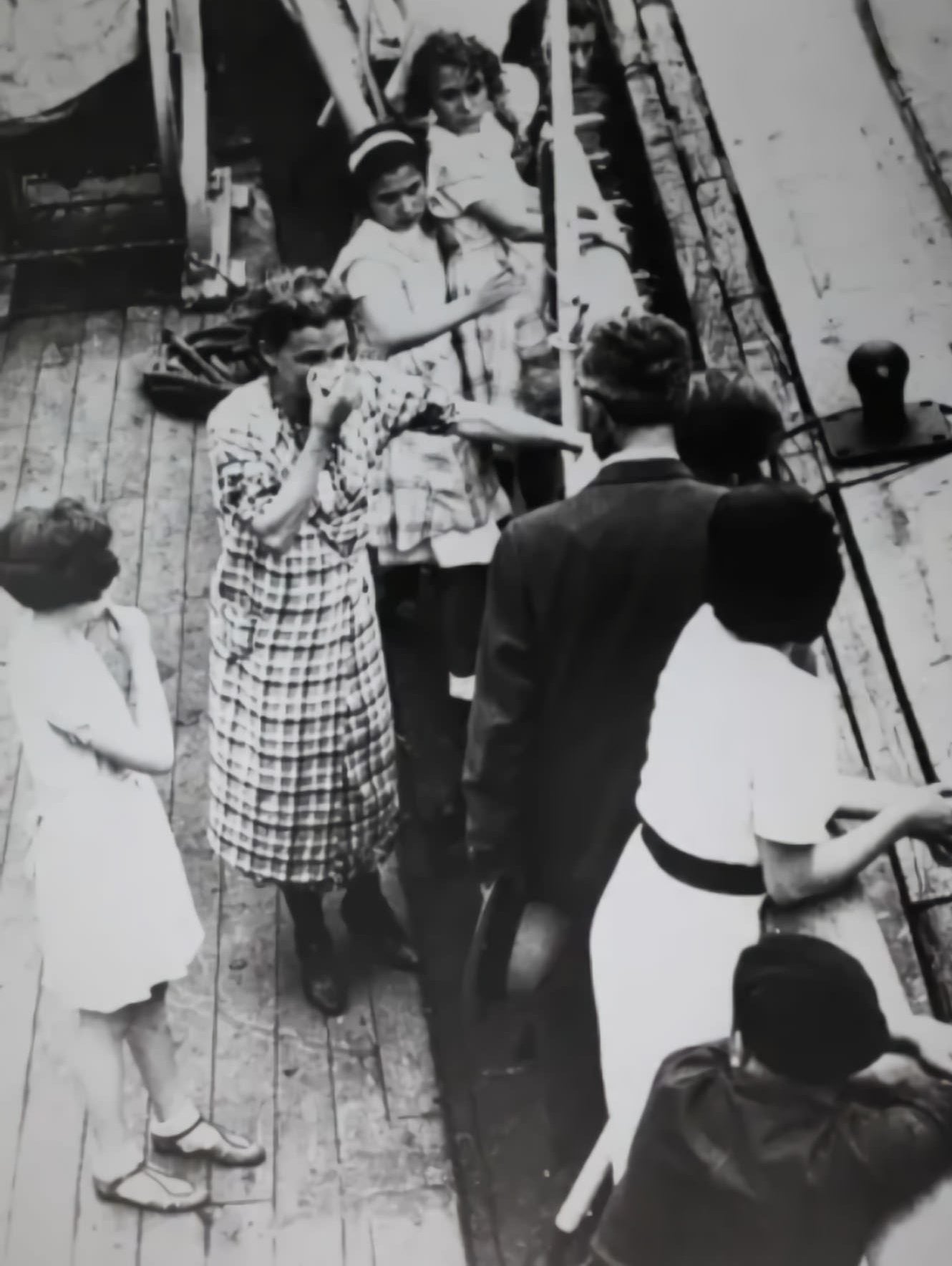 Keystone, Back to Europe (1939), photo, Gamma-Keystone Collection/Getty Images https://www.gettyimages.com/photos/st-louis-ship?editorialproducts=gammakeystone&family=editorial&phrase=st%20louis%20ship&sort=mostpopular#license
Keystone, Back to Europe (1939), photo, Gamma-Keystone Collection/Getty Images https://www.gettyimages.com/photos/st-louis-ship?editorialproducts=gammakeystone&family=editorial&phrase=st%20louis%20ship&sort=mostpopular#licenseThroughout Adolf Hitler’s rise to power and most of the Holocaust, the United States maintained its highly restrictive immigration laws. In 1939, when the USS St. Louis, a ship carrying over 900 refugees of Nazi Germany, reached Miami after having been turned away by Cuba, the U.S. refused to grant them entry.26United States Holocaust Memorial Museum, Holocaust Encyclopedia, “Voyage of the St. Louis” A number of passengers sent telegrams to President Roosevelt, pleading for asylum. In return, the passengers received a telegram from the State Department: “the passengers must await their turns on the waiting list and qualify for and obtain immigration visas before they may be admissible into the United States.”27Susan F. Martin, A Nation of Immigrants (Cambridge University Press, 2011), 163. In the end, U.S. authorities forced the refugees to return to Europe. Upon their return, nearly one third of the St. Louis’s passengers were murdered in the Holocaust.
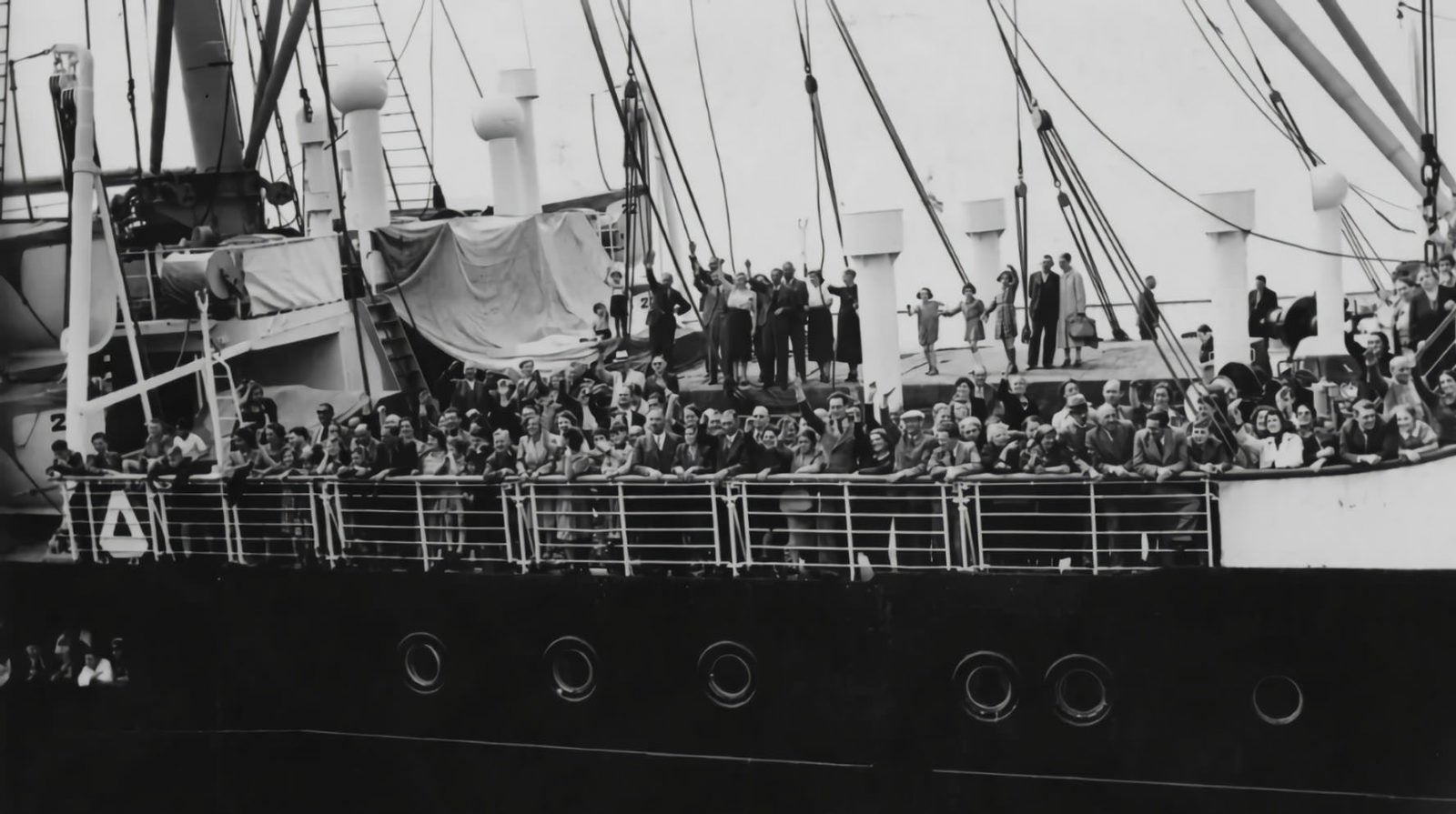
World War II
Even as the United States observed the rise of fascism in Europe, plenty of Americans were sympathetic to Nazism, and much of America remained complicit in the Jim Crow racial caste system that legally suppressed Black American life. In fact, Nazi race laws drew directly from the influence of American racial policies.28James Q. Whitman, Hitler’s American Model: The United States and the Making of Nazi Race Law (Princeton University Press, 2017). Significant numbers of Americans even believed in promoting an ideology that would grant “Aryans” superiority over Black, Jewish and other “inferior” groups in their own country. In 1939, for example, the pro-Nazi German American Bund, which hosted youth training camps across the country, held a rally at Madison Square Garden, spewing vicious antisemitism into a crowd of 20,000 cheering Americans.29A Night at the Garden (documentary film), directed by Marshal Curry, distributed by First Look Media (2017); Arnie Bernstein, Swastika Nation: Fritz Kuhn and the Rise and Fall of the German-American Bund (St. Martin’s Press, 2013). More broadly, frequent antisemitic commentaries in Protestant presses and churches of the 1930s made the news of Nazis’ anti-Jewish atrocities less surprising to the American public.30Leonard Dinnerstein, Antisemitism in America (New York: Oxford University Press, 1994), 99. One poll from July 1939 found that fewer than 40 percent of Americans believed Jews should be treated “as any other Americans.”31Hazel Gaudet Erskine, “The Polls: Religious Prejudice, Part 2: Anti-Semitism,” The Public Opinion Quarterly vol. 29, no. 4 (Winter 1965-1966): 653.
After the United States entered World War II, staunch isolationists blamed Jews for dragging the nation into overseas conflict. The world-famous aviator and anti-interventionist Charles Lindbergh went so far as to claim in 1941 that Jewish control of “our motion pictures, our press, our radio and our Government” was what truly endangered the American people.32Jonathan D. Sarna, American Judaism (Yale University Press, 2004), 266. Daily antisemitic violence plagued Jews in the streets of some major American cities, typically perpetrated by members of neighboring German and Polish immigrant communities where antisemitism thrived. Such individuals found encouragement in Father Coughlin’s newspaper Social Justice, which published over 100 antisemitic articles at a circulation of over 1,000,000 copies from 1940-1942.33Leonard Dinnerstein, Antisemitism in America (New York: Oxford University Press, 1994), 132. And even late into the war, in 1944, 60 percent of Americans still claimed to have heard recent “criticism or talk against Jews.”34Jonathan D. Sarna, American Judaism (Yale University Press, 2004), 266. All in all, the country had become accustomed to the normalization of antisemitism.
While antisemitism persisted at home, about 550,000 American Jews fought alongside their countrymen in World War II, and 36,000 were decorated for their bravery.35Jon Efron, The Jews: A History (Pearson, 2009), 421. By the war’s end, widespread American awareness of the Holocaust and of America’s victory over Nazism — as well as interactions with Jewish soldiers in the armed services — transformed American society’s beliefs and treatment of Jews.
Post-World War II Shift in Antisemitism
Post-1945, publicly expressed antisemitism declined dramatically in the United States. The percentage of Americans who reported hearing recent criticism of Jews plummeted from 64 percent in 1946 to 16 percent in 1951. In postwar public discourse, commentators began to discuss Protestantism, Catholicism and Judaism as America’s three prominent spiritual traditions — a “Judeo-Christian” tradition.36Jonathan D. Sarna, American Judaism (Yale University Press, 2004), 266-267. Part of the change in the condition of Jewish life in America was a result of the significant improvement in Catholic-Jewish relations, beginning with the historic meeting of the Second Vatican Council in 1965. The Second Vatican Council notably repealed the historic Church theme of collective responsibility for the Jews in the death of Jesus that has been the source of antisemitism through the ages, and opened a path to new relations between the members of the two religions.37Vatican; “Declaration on the Relation of the Church to Non-Christian Religions,” http://www.vatican.va/archive/hist_councils/ii_vatican_council/documents/vat-ii_decl_19651028_nostra-aetate_en.html.
As the civil rights era gained momentum in the second half of the 20th century, Jews gradually were loosened from the grip of discrimination that had blocked their entry into universities, success in the job market and access to the housing market. Though some exclusionary practices persisted, such as those that inhibited Jews from succeeding in certain professions or entering particular social venues, by the 1970s antisemitism indisputably was shifting to the margins of American society.38Dinnerstein, 155, 157; Charles H. Stember et al, Jews in the Mind of America (1966), 96–97.
 Haun, Declan, White Power (1966), photo, Chicago History Museum http://interactive.wbez.org/curiouscity/chicagonazineighborhood/
Haun, Declan, White Power (1966), photo, Chicago History Museum http://interactive.wbez.org/curiouscity/chicagonazineighborhood/Helping to fuel that hatred of those at the margins was the involvement of the American Jewish community in the civil rights movement. Unsurprisingly, white supremacists39In this guide, the term “white supremacy” refers to extremist ideologies which believe that white people are genetically or culturally superior to non-whites and/or that white people should live in a whites-only society. The guide is not using the term “white supremacy” to refer to the systematic marginalization or oppression of people of color based on a socially constructed racial hierarchy that privileges people who identify as white. lashed out against both Black and Jewish communities, envisioning a corruption of white America that they blamed on Jewish plotting. George Lincoln Rockwell, founder of the American Nazi Party, even called in 1967 for the deportation of all Black people to Africa and of “Communist Jews” to gas chambers.40Michael E. Miller, “The shadow of an assassinated American Nazi commander hangs over Charlottesville,” Washington Post, August 21, 2017, https://www.washingtonpost.com/news/retropolis/wp/2017/08/21/the-shadow-of-an-assassinated-american-nazi-commander-hangs-over-charlottesville/ Synagogues and Jewish community centers, along with Black churches, were targets of bombings.41Isabel Fattal, “A Brief History of Anti-Semitic Violence in America,” The Atlantic, October 28, 2018, https://www.theatlantic.com/politics/archive/2018/10/brief-history-antisemitic-violence-america/574228/.
 uncredited photographer, Leader and Members of the American Nazi Party (1961), photo, Bettman Archive/Getty Images https://www.gettyimages.com/detail/news-photo/george-lincoln-rockwell-and-followers-of-his-american-nazi-news-photo/514702584
uncredited photographer, Leader and Members of the American Nazi Party (1961), photo, Bettman Archive/Getty Images https://www.gettyimages.com/detail/news-photo/george-lincoln-rockwell-and-followers-of-his-american-nazi-news-photo/514702584Nevertheless, as the 20th Century turned to the 21st, the extent of how far Jews came to be accepted in the United States can be illustrated in for the first time, a major political party nominating not just an American Jew — but an observant one — to be its vice-presidential candidate. Indeed, the Joe Lieberman candidacy and the acceptance of it is but one measure of the American Jewish community’s acceptance and success.
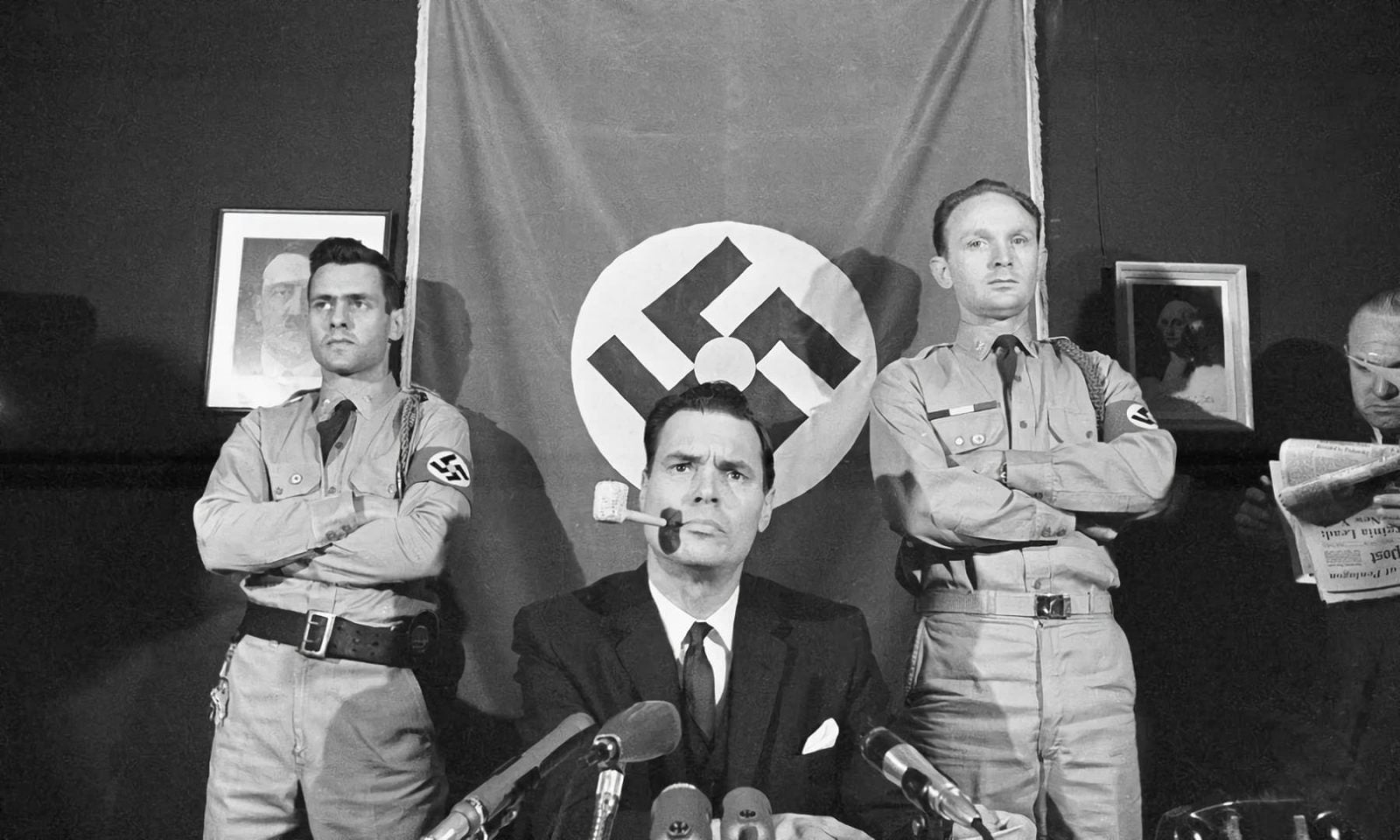
Antisemitism Today
And yet, antisemitism has not been extinguished entirely. In fact, there are numerous indicators that demonstrate its lasting presence.
Widespread anxiety about globalization, mass migration and economic inequality — especially after the 2008 financial crisis — have created the conditions in which antisemitism has always festered.42Russell Berman, “What’s behind the disturbing reemergence of anti-Semitism?” The Hill, March 4, 2019, https://thehill.com/opinion/civil-rights/432493-identifying-the-roots-of-anti-semitisms-disturbing-reemergence. Seeking a simple explanation for complex social change, anti-Jewish bias serves as a useful smokescreen as some people entertain a familiar conspiracy theory: when transnational forces provoke crisis or cause injustice, they allege that Jews must be responsible. The term “globalist” — often used as a derogatory code-word for Jews — evokes this antisemitic myth, falsely accusing mysterious agents of multiculturalism and international cooperation of weakening America from within.
Today, antisemitism within some segments of the American population reflects the same patterns of scapegoating, mistrust, and bigotry that have emerged and reemerged over the past two centuries.
Accelerating the spread of antisemitism are social media and other tech platforms, including platforms that accompany online gaming, which have made it easier for antisemites to communicate and cultivate destructive online communities, developing their own vocabulary, code words and tropes, which often widely spread as memes. This problem has persisted online during this time. Launched in 1995, Stormfront is one of the most prominent white supremacist message boards and still operates today.43JM Berger, “The Strategy of White Supremacists Is Evolving,” The Atlantic, August 7 2019. However, this phenomenon took center stage in 2016 with the emergence of the so-called alt right, a loose political grouping of right-wing extremists that rejects traditional conservatism and embraces racist nationalism, and actively infuses ordinary symbols and memes with antisemitic meaning. This group cleverly exploited public platforms like Facebook, Twitter and YouTube in an effort to mainstream their messages and spread their reach long before the general public took note of their activity.
With few or no restrictions on hate speech set or enforced by the companies, a handful of social networking platforms and online forums like 4chan, 8chan and Gab became appealing destinations for antisemites of all stripes. They allow antisemites and others who purvey virulent hatred to disseminate openly their views no matter how bigoted or violent.
Further fueling this rise in antisemitism, this hate has seeped from these recesses into the public conversation. For example, the increasingly hostile tone of political debate in the U.S. has inspired fringe elements on both sides of the ideological spectrum. This is most pronounced on the extreme-right. Right-wing white supremacists have been responsible for nearly all of the devastating acts of violence against Jewish communities as well as other marginalized communities in the U.S. Such extremists reportedly have been emboldened by former President Trump’s adoption of specific elements of their rhetoric and his dismissal of their hate, such as his use of terms like “globalist” or “migrant caravans” or even his campaign slogan, America First.44ADL, “White Supremacists, Extremists Celebrate President Trump’s Latest Racist Tweets,” https://www.adl.org/blog/white-supremacists-extremists-celebrate-president-trumps-latest-racist-tweets.; Aaron Blake, “Trump tries to re-write his own history on Charlottesville and ‘both sides’,” Washington Post, April 26, 2019, https://www.washingtonpost.com/politics/2019/04/25/meet-trump-charlottesville-truthers/. All of this has helped to fuel a movement that appears to be growing and carries the potential to do great harm. This movement gained national attention in August 2017, when white supremacists, neo-Nazis and other like-minded extremists gathered for the “Unite the Right” rally in Charlottesville, Virginia. Their brazen chants of “Jews will not replace us!” evoked the longstanding white supremacist claim that Jews are conspiring to destroy pure, white American society. One man rammed his car into a group of peaceful counter-protestors, killing a young woman.

During the year of the Charlottesville rally, antisemitic incidents rose by 57 percent (from 2016 to 2017), the largest single-year increase since the ADL began tracking complaints almost 40 years earlier.45ADL, “ADL Calls on Leaders to Redouble Efforts to Counter Hate After FBI Reports Hate Crimes Jumped 17 Percent,” https://www.adl.org/news/press-releases/adl-calls-on-leaders-to-redouble-efforts-to-counter-hate-after-fbi-reports-hate.46ADL, “2017 Audit of Anti-Semitic Incidents,” https://www.adl.org/resources/reports/2017-audit-of-anti-semitic-incidents. Hate crimes in general hit a 27-year high in 2018, with Jews and Jewish institutions constituting the most frequent target of religion-based incidents by a large margin. 47ADL, “ADL Urges Action After FBI Reports Jews Were Target of Most Religion-Based Hate Crimes in 2018,” November 12, 2019, https://www.adl.org/news/press-releases/adl-urges-action-after-fbi-reports-jews-were-target-of-most-religion-based-hate.
 Platt, Spencer, White Nationalists Hold Rally In Georgia (2018), photo, Washington Post/Getty Images https://www.gettyimages.com/detail/news-photo/members-of-the-national-socialist-movement-one-of-the-news-photo/949804550
Platt, Spencer, White Nationalists Hold Rally In Georgia (2018), photo, Washington Post/Getty Images https://www.gettyimages.com/detail/news-photo/members-of-the-national-socialist-movement-one-of-the-news-photo/949804550Tragically, antisemitic murders would occur over the next two years. On October 27, 2018 — the most deadly day of violence against Jews to take place on American soil — a white supremacist, shouting “all Jews must die,” opened fire on worshippers of the three congregations meeting at the Tree of Life synagogue in the Squirrel Hill neighborhood of Pittsburgh, killing 11 and wounding six. Just hours before, the gunman had posted a vicious online message against HIAS, a Jewish refugee resettlement organization that has helped Jews to flee political antisemitism and other immigrants fleeing persecution and war, and that more recently opposed the White House’s policy to bar the entry of refugees.48Julia Neuberger, Antisemitism: What It Is. What It Isn’t. Why It Matters. (London: Weidenfeld & Nicolson, 2019), 132.49ADL, “Deadly Shooting at Pittsburgh Synagogue,” October 27, 2018, https://www.adl.org/blog/deadly-shooting-at-pittsburgh-synagogue. Blaming Jews for bringing “invaders that kill our people,” the gunman echoed the centuries-old accusation that Jews are master puppeteers who threaten white America—in this instance, by welcoming Muslim refugees and promoting immigration on the southern U.S. border.50Masha Gessen, “Why the Tree of Life Shooter Was Fixated on the Hebrew Immigrant Aid Society,” New Yorker, Oct. 27, 2018, https://www.newyorker.com/news/our-columnists/why-the-tree-of-life-shooter-was-fixated-on-the-hebrew-immigrant-aid-society51ADL, “Deadly Shooting at Pittsburgh Synagogue,” October 27, 2018, https://www.adl.org/blog/deadly-shooting-at-pittsburgh-synagogue. Then, on the six month anniversary of the Pittsburgh massacre, a white-supremacist gunman opened fire at Chabad of Poway, a synagogue in the San Diego area, killing one attendee and injuring three more. Shortly before the attack, the gunman had posted a link to an antisemitic manifesto on 8chan, which was succeeded by 8kun, composed of user-created message boards.
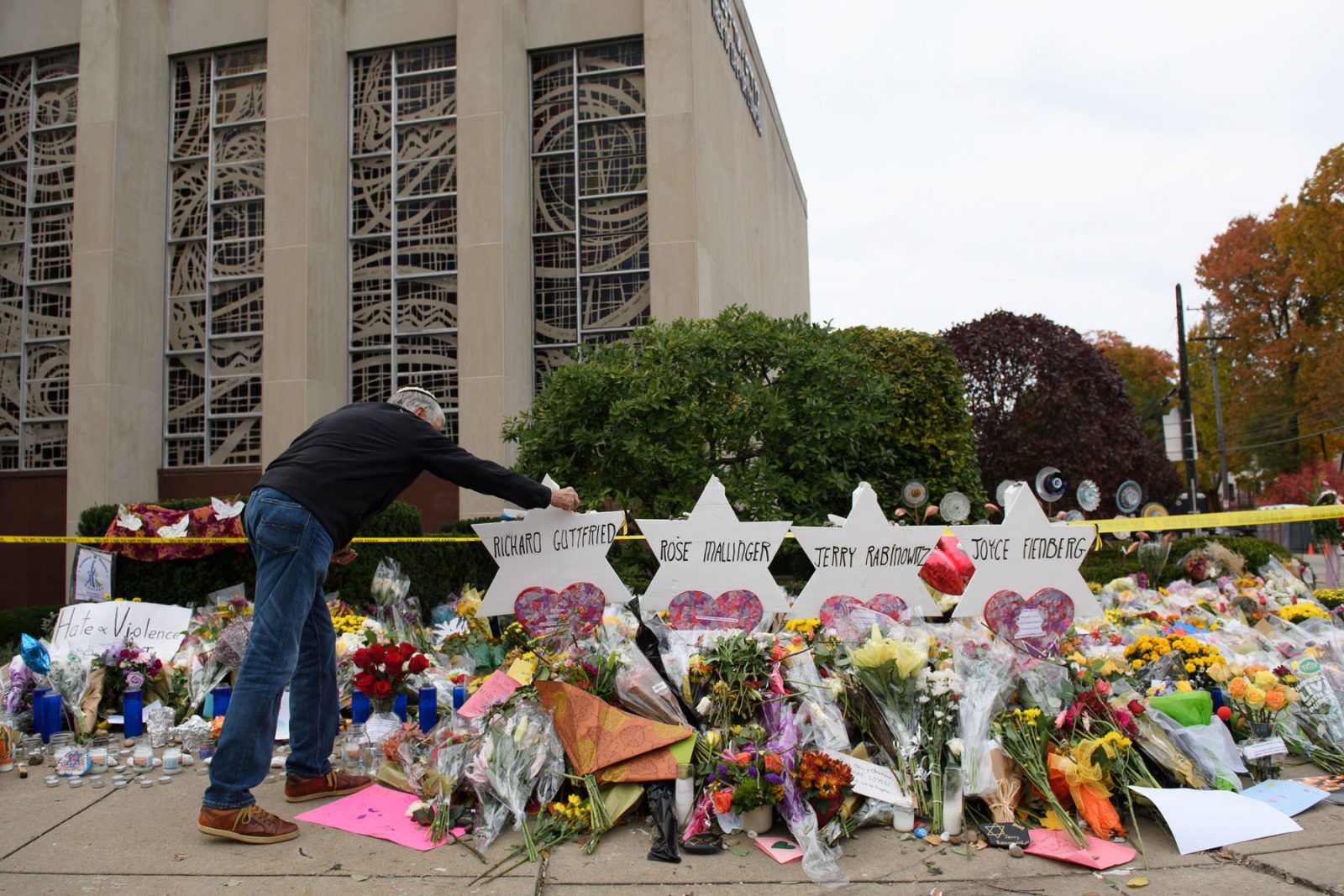
In the year after the Pittsburgh shooting, the FBI claims to have taken action against at least 12 violent plots or threats prepared by white supremacists against Jewish communities.52ADL, “Latest ADL Data: At Least 12 White Supremacists Arrested for Plots, Attacks & Threats Against Jewish Community Since the Deadly Pittsburgh Shooting,” October 20, 2019, https://www.adl.org/news/press-releases/latest-adl-data-at-least-12-white-supremacists-arrested-for-plots-attacks. And it’s not only white nationalists attempting to commit such crimes. Radical interpretations of Islam also have traded in antisemitic conspiracy theories and promoted anti-Jewish violence in America. Since 2016, the FBI has thwarted at least three lethal attacks planned against Jews by extremist Islamist plotters inspired by the terrorist group ISIS53Josh Campbell, “Thwarted terrorist plot in Times Square reveals ISIS’ lingering threat,” CNN, June 7, 2019, https://www.cnn.com/2019/06/07/opinions/terrorist-plots-new-york-los-angeles-isis-campbell/index.html; United States Department of Justice, Office of Public Affairs; “Ohio Man Arrested on Terrorism Charge After Planning Attack on Jewish Synagogue, Dec. 10, 2018, https://www.justice.gov/opa/pr/ohio-man-arrested-terrorism-charge-after-planning-attack-jewish-synagogue; Marcy Oster, “Arizona Islamist Terror Suspect Eyed Tucson JCC,” The Forward, July 20, 2016, https://forward.com/news/breaking-news/345611/arizona-islamist-terror-suspect-eyed-tucson-jcc/. and by so-called “lone wolves.”54Richard Winton, “LA Terror Plot Foiled,” LA Times, April 29, 2019.
Despite these successes, 2019 was scarred by the rise of antisemitic violence of a different nature in the New York City area. Acts of violence and harassment against Hasidic Jews have been prominent. These antisemitic acts are not connected to white supremacists. A number of them came from diverse groups, including individuals of color, against Jews who are identifiable based on their dress, and they speak to the fact that antisemitism is a societal problem. It is not limited to one ideology, one community or one political trend. There were multiple high-profile incidents including an attack in Jersey City, NJ where gunmen laid siege to a kosher supermarket and murdered three people, as well as Monsey, NY where a man burst into the home of the local rabbi and used a machete to wound five people before he was chased away. In addition, there has been a sustained pattern of antisemitic acts in Brooklyn, NY where the visibly Orthodox Jewish community long has been subjected to harassment, vandalism and an increasing degree of violence.
Even if it lacks the violent tenor of these acts, antisemitism also is evident within circles of the political left. Committed to antiracism, many on the left invoke the social theory of intersectionality55Other adherents of intersectionality dispute this use of the theory. Intersectionality is a term first coined by UCLA and Columbia Law School Professor and critical race theorist Kimberle Crenshaw to describe a theoretical framework for understanding how aspects of an individual’s identity might combine to create unique modes of discrimination. Crenshaw first focused on how the law was used to deny black women rights of recourse where they alleged discrimination based on both sex and race. [ Crenshaw, Kimberle “Demarginalizing the Intersection of Race and Sex: A Black Feminist Critique of Antidiscrimination Doctrine, Feminist Theory and Antiracist Politics,” University of Chicago Legal Forum: Vol. 1989: Iss. 1, Article 8.. https://chicagounbound.uchicago.edu/cgi/viewcontent.cgi?article=1052&context=uclf] to conflate Jews, as a whole, with privileged white elites. Such racial stereotyping of Jewishness erases Jews of color, who experience both antisemitism and racism.56Bernard J. Wolfson, “African American Jews: Dispelling Myths, Bridging the Divide,” in Black Zion: African American Religious Encounters with Judaism, ed. Yvonne Chireau and Nathaniel Deutsch (Oxford University Press, 1999), 38. Painting all Jews as white also ignores a basic fact of history: not even Jews who consider themselves white have been safe from persecution or even genocide when antisemitism has gained traction. Despite the fact that American Jews today are increasingly targeted by white supremacists, radical Islamists and subjected to other forms of abuse, some prominent antiracists on the left maintain a generalized notion of Jewish privilege and refuse to see Jews as a population vulnerable to racist attack.57Julia Neuberger, Antisemitism: What It Is. What It Isn’t. Why It Matters. (London: Weidenfeld & Nicolson, 2019), 152. Jews, only being afforded one half of the intersectionality theory, share the privilege and concomitant criticism associated with their perceived whiteness. Yet at the same time, they are denied participation in the intersection of prejudice, excluded from conversations and spaces reserved for marginalized communities, despite the ample historical and contemporary Jewish experience with discrimination.
 Rob Stothard, Gay Pride is Celebrated in London (2015), photo, Getty Images News https://www.gettyimages.com/detail/news-photo/people-take-part-in-the-annual-pride-in-london-parade-on-news-photo/478745254 https://www.pinknews.co.uk/2017/06/25/chicago-pride-faces-controversy-as-it-bans-jewish-flags/
Rob Stothard, Gay Pride is Celebrated in London (2015), photo, Getty Images News https://www.gettyimages.com/detail/news-photo/people-take-part-in-the-annual-pride-in-london-parade-on-news-photo/478745254 https://www.pinknews.co.uk/2017/06/25/chicago-pride-faces-controversy-as-it-bans-jewish-flags/It also manifests itself under the rubric of anti-Zionism as a tool to exclude Jews. This has been visible in political movements like the Chicago and DC Dyke Marches, which forbade the display of the Star of David, a Jewish cultural symbol that also appears on the Israeli flag, deeming it too “nationalist,” in 2017 and 2019, respectively.58Avichai Scher, “Israeli-Palestinian conflict tears into LGBTQ Jewish community,” NBC News, June 21, 2019, https://www.nbcnews.com/feature/nbc-out/israeli-palestinian-conflict-tears-lgbtq-community-n1019916. The inconsistent application of this principle to other icons led many to accuse them of antisemitism. This tendency also has been evident among some public figures like progressive advocate Linda Sarsour who once derided “Zionists” as incapable of being true feminists. Sarsour’s comments on the feminist movement intentionally overlook the important roles played by many Jewish feminist activists who support the existence of the State of Israel.59Gabriel Noah Brahm, “Intersectionality,” Israel Studies 24.2 (2019): 163-164.
 Jackson, Lucas, Anti-Israel Protest (2014), Reuters https://www.mindingthecampus.org/2015/12/01/our-anti-israel-american-universities/
Jackson, Lucas, Anti-Israel Protest (2014), Reuters https://www.mindingthecampus.org/2015/12/01/our-anti-israel-american-universities/Different forms of extremism also have reared their heads on many American college campuses in recent years, contributing to hostile atmospheres for Jewish students and those hailing from other marginalized groups. According to a recent study, white supremacist propaganda increased for the third straight year in the 2018-2019 school year, with Spring 2019 showing the most extremist white supremacist propaganda on campus.60ADL, “White Supremacists Continue to Spread Hate on American Campuses,” June 27, 2019, https://www.adl.org/blog/white-supremacists-continue-to-spread-hate-on-american-campuses. But the greatest challenges confronting Jewish students on campus occur in the context of events, activity or rhetoric which are critical of Israel in a manner that invokes anti-Jewish tropes or conspiracies, campaigns such as Boycott, Divestment and Sanctions (BDS) initiatives that make Jewish students feel isolated or beleaguered or their exclusion from campus groups or initiatives unless they explicitly negate any connection to Israel. Often such events and initiatives are framed as criticism of Israel, but all too frequently devolve into classic antisemitism, invoking conspiracy theories and longstanding tropes to characterize Israel as well as holding all Jewish students collectively responsible for perceived injustices committed by the Jewish state. Such activity typically has made all identified Jews targets on campus, regardless of their position on Middle East issues or their level of religious observance or political engagement.
Anti-Zionism as antisemitism exploded in the aftermath of the horrific October 7th terrorist attack on Israel particularly from anti-Israel activists. At rallies across the United States, speakers and attendees justified and celebrated Hamas’s murder of Israelis. Organizers of these rallies have included groups such as Students for Justice in Palestine (SJP), Palestinian Youth Movement (PYM), U.S. Palestinian Community Network (USPCN), Within Our Lifetime-United for Palestine (WOL), Jewish Voice for Peace (JVP) and If Not Now (INN), among others. Many of these groups have a history of promoting classic antisemitic themes on social media, at rallies and other forums.
Students have faced unprecedented levels of antisemitism on campuses in the wake of October 7th. Seventy-three percent of Jewish college students surveyed experienced or witnessed some form of antisemitism in the fall of the 2023-2024 school year alone. A plurality of Jewish college students reported that they do not feel physically safe on campus after October 7th, and even fewer feel emotionally safe. Since October 7, the percentage of Jewish students who said they feel comfortable with others on campus knowing they are Jewish dropped by nearly half.61 Campus Antisemitism: A Study of Campus Climate Before and After the Hamas Terrorist Attacks
https://www.adl.org/resources/report/campus-antisemitism-study-campus-climate-and-after-hamas-terrorist-attacks
ADL Center for Antisemitism Research (CAR), Hillel International, and College Pulse conducted a longitudinal survey of American college students before and after the Hamas terror attacks on October 7, 2023.
The need to combat antisemitism reflects a broader need to deny toxic norms of prejudicial thinking that threaten our society as a whole. While some find it tempting to scapegoat a marginalized group in times of social crisis, doing so sets the stage for a dangerous political landscape that threatens everyone. Where one form of hatred is tolerated, another may soon follow. As history shows us, once antisemitic conspiracy theories are used to justify discriminatory policies and hate-based violence, those policies and acts of violence are often extended to other groups.62Jews For Racial & Economic Justice; “Understanding Antisemitism: An Offering To Our Movement,” https://jfrej.org/understanding-antisemitism-an-offering-to-our-movement/.
Understanding how antisemitism has infiltrated both populist and elite segments of our nation across the political spectrum, it is crucial that we do not ignore hateful comments we hear about Jews or instances of anti-Jewish behavior we encounter in our daily lives. We are reminded of the danger of such hate-based thinking when we see swastikas painted on the side of a building or read about acts of harassment, or even outright violence, targeting observant Jews in Brooklyn or Rockland County. None of these acts might be the product of a coordinated campaign, but that doesn’t diminish the pain felt by the victims or the fuel such acts provide to hate-based ideologies that can enact much greater harm.
Having shifted its basis from theology to racism, eugenics and social theories, antisemitic myths rest on a blend of different ideologies and belief systems. In order to disprove or counter any given antisemitic myth, we must first disentangle and understand the foundational beliefs on which that myth rests.63Till van Rahden, “American Jewish History,” American Jewish History 83, no. 4 (1995): 507-511, cited in Jews For Racial & Economic Justice; “Understanding Antisemitism: An Offering To Our Movement,” https://jfrej.org/understanding-antisemitism-an-offering-to-our-movement/. In the pages that follow, we dissect the most prominent antisemitic myths in the hopes of promoting not just understanding, but also a future that is less violent and volatile than the past.
Join The Fight
Antisemitism Uncovered is a guide to help you understand more about the history and current manifestations of antisemitism. What’s the next step? Join the fight against it! We’ve gathered all our most practical resources—the tools and strategies you need to engage in that fight—in one place: right here in Antisemitism Uncovered Toolkit: Resources to Speak Up, Share Facts and Show Strength Against Hate.
